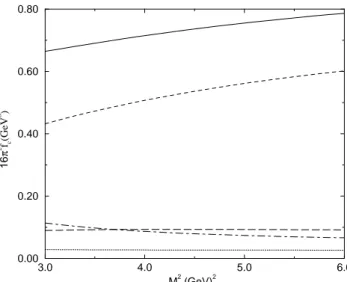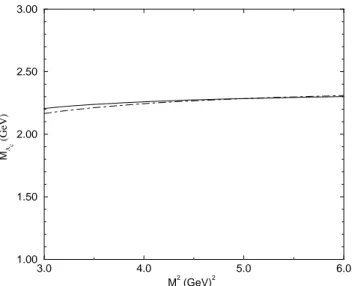Instanton Eets in Heavy Lambda Masses
HilmarForkel,
Institutf urTheoretishe Physik,UniversitatHeidelberg,
Philosophenweg19,D{69120Heidelberg,Germany
Fernando S. Navarra, and Marina Nielsen
Instituto deFsia,UniversidadedeS~aoPaulo,
C.P.66318, 05315-970S~aoPaulo,SP,Brazil
Reeivedon17August,2000
We alulate the masses of b and in the frameworkof QCD sum rules inluding instanton
ontributions. We nd thatthese ontributions have thesame size of thefour quarkondensate
ontribution and improve the Borel stability inboth Dira strutures of the baryon orrelation
funtion.
I Introdution
Theammountofdataonheavybaryonsisalready
im-pressive. Alone in the harm setor, for example, 17
baryons have been seen. New data an be expeted
to emergein the near future when CLEO III,BaBar,
HERA-B andCDF/D0 begintaking data. With these
aumulationofexperimentaldata,morereliable
theo-retialalulationsareneeded.
From the theoretial point of view [1℄, heavy
baryonsprovideuswithagoodtestinggroundforQCD.
In priniple,beauseof thelargemasses involved, the
perturbative ontribution, whih is under ontrol, is
dominantand nonperturbative (not ompletely under
ontrol) are orretions. Moreover, they oer an
ad-vantageoverheavy-lightmesons(wherewealsohavea
large mass sale), namely, they are the ideal plae to
studythedynamisofadiquarksysteminthe
environ-mentofaheavyquark.
Nonperturbativeeets an beomputed in
dier-ent expansion shemes, one of them being QCD sum
rules. Inthestudyofthediquarkdynamis,instantons
mayplayaruial roleandhaveto beinludedin the
sumruleapproahto heavybaryons.
Thealulationofbaryonmasseswithinthe
frame-work of QCD sum rules is quite appealing, sine in
thisapproah,thehadronpropertiesarerelatedtothe
fundamentalparametersofQCD:quarkmassesand/or
QCDvauumondensates.
Theappliationof thismethod to thelightbaryon
systems has shown that the baryon masses are
essen-tiallydeterminedbythehiralsymmetrybreaking
on-densates. Another nonperturbative ontribution may
omefrominstantons. Indeed,overthelastyears
grow-hadronstruture hasbeenolleted. Itoriginatedrst
frommodelsbuiltoninstantonvauumphenomenology
[2,3℄andreentlyreeivedmodelindependentsupport
fromooledlattiestudies[4℄.
Intheaseofheavybaryonsystemswewouldexpet
theinstantonontributiontobeevenmorepronouned
beauseofthesmalldistanesinvolved,whihenhane
theroleplayedbysmallsizeinstantonsandreduethe
relativeimportaneofotherondensates. Moreover,in
a heavy baryon, aording to Heavy Quark Eetive
Theory(HQET),the main quantum numbersare
ar-riedby the heavyquarkand the diquark behaveslike
asalarobjet. It is known that instantonsare more
ativeinthesalarandpseudosalarhannel[5,6℄. We
mightthereforeexpetthemtoberesponsibleforsome
substanialeetin heavybaryonsproperties.
Theimportane ofexpliitinstantonorretionsin
thenuleonmasshavebeenaddressedinRef.[5,7℄. The
orretionsinthenuleonhannelturnouttobesmall
in the hirally-even orrelator and in the
orrespond-ing sum rule, but signiant in the hirally-odd one.
Indeed,thehirally-oddsumruleouldhardly be
sta-bilizedwithoutinstantonorretions,whereasthe
hi-rally even one is stable and in agreement with
phe-nomenology even if the instanton ontribution is
ne-gleted[8℄.
In Ref.[9℄ the spetraof heavybaryons were
om-puted in the framework of QCD sum rules. Whereas
satisfatoryresultswere foundforthe
;b
,inthease
of the
and
b
partiles the authors onlude that
thereisnoBorelstabilityinthissumruleandtherefore
noreliablepreditions anbemade for therespetive
withintheframeworkofHQET.
Sine instantons were shown to stabilize one the
nuleon mass sum rules and sine in heavy baryons
they should be the most important soure of
non-perturbativeeets,wewill,inthiswork,reanalyzethe
alulationofRef. [9℄inludingtheinstanton
ontribu-tionandinvestigateitsonsequenesfortheBorel
sta-bilityofthebaryonorrelators. Weaddressspeially
theheavy'sbeausetheywere\theproblemati
par-tiles", but thealulation ould be straightforwardly
extended tothe 's. However,asitwillbeomelear,
thereisnoneedtodothisextention.
Analmotivationforinludinginstantonsinheavy
baryon alulationsis the fat that theygenerate
dif-ferenteetsindierentDirastrutures. Thisis
espe-iallywelomeintheQCDsumruleanalysisof
semilep-toniheavydeays. Itwasfoundin[12℄thatthetotal
deayratevariesbyafator3whendierentstrutures
areonsidered. Thisisanindiationthatsomephysis
isstillmissingand,inviewofthestruturedependene
oftheresults,weshallhekwhetherinstantonsarethis
missingontribution.
II Instanton Contribution
We now evaluate the small-sale instanton
ontribu-tions to the
Q
(where Q stands for or b)
orrela-tors. Webeginwiththeheavy
Q
orrelationfuntion,
whih is haraterizedby two invariant amplitudes of
oppositehirality,
(q)=i
Z
d 4
xe iqx
h0jT
(x)
(0)j0i =i Z
d 4
xe iqx
(x)=/q
q (q
2
)+
1 (q
2
) (1)
Theompositeoperator
isbuiltfromQCDeldsandservesas aninterpolatingeld for
Q
. Weadopt:
(x)=
ab
u T
a (x)C
5 d
b (x)
Q
+b
u T
a (x)Cd
b (x)
5 Q
(2)
d
whereu,dandQarequarkeldsandbisaparameter.
Inserting(2)intheintegrandof(1)wearriveat
(x)=S
Q
0
(x)L
0(x;0) (3)
whereS Q
0
(x)istheheavyquarkpropagatorand
L
0
(x;0)=
ab
a 0
b 0
0
Tr[S d
aa 0(x)
5 CS
uT
bb 0(x)C
5 ℄
(4)
where S d
aa 0
(x) andS uT
bb
0(x) are respetivelythe dand
(transposed)uquarkpropagatorsand C istheharge
onjugationoperator.
Theleadinginstantonontributionsto the
orrela-tors anbe alulatedin semilassialapproximation,
i.e. byevaluating (4)in thebakgroundofthe
instan-ton eld and by taking the weighted average of the
resulting expression over the quantum distribution of
theinstanton'solletiveoordinates[5℄. These
ontri-butionsaddnonperturbativeorretionstotheWilson
oeÆientsof the onventional OPE, with whih they
willbeombined.
Therationalebehindthesemilassialtreatmentof
instantonontributions and the alulational strategy
areanalogous to thosepresentedin ref. [5,7℄, andwe
thusjust skeththeessentialstepshere. Toleading
or-derintheprodutof quarkmassesand instantonsize,
atedwiththequarkzero-modes[13℄
0 (x)=
1
5
(r 2
+ 2
) 3=2
/ r
r
U; (5)
where thesupersript orresponds to an (anti-)
in-stantonof size with enter atz. Thespin-olor
ma-trixU satises(~+~)U =0andr=x z. Thezero
modeontributionsenterthealulationofthe
orrela-torsthroughtheleadingterminthespetral
represen-tationofthequarkbakgroundeldpropagator
S
q
(x;y)=
0 (x)
0 y
(y)
m
q ()
+O(m
q
): (6)
The avor dependent eetive quark mass m
q () =
m
q 2
3
2
2
hqqi(whereqstandsforupordownquarks)
in the denominator is generated by interations with
long-wavelengthQCDvauumelds[14℄. Quark
prop-agationinthehigher-lyingontinuummodesinthe
in-stanton bakgroundwill be approximatedasin [7℄ by
thefreequarkpropagator.
Notethatboththezeroandontinuummode
prop-agatorsareavordependent. Thezeromodepart
on-tains the eetive quarkmass, whih depends on the
urrentquarkmassesandontheorresponding
onden-sates. Theurrentquarkmasses enter, of ourse,also
the ontinuum mode ontributions. Beause of 1=m
With the quark bakground eld propagator at
hand, theinstantonontributions to theLambda
or-relatorsanbeevaluated.
For the funtion L (the olor indies have been
summed)weobtain:
L
I+I
(x;0) = 8 4 Z d 4 n() m 0 2 () Z d 4 z 1 [(x z) 2 + 2 ℄ 3 [z 2 + 2 ℄ 3 ;(7)
where the subsript I +I indiates that the
instan-tonandanti-instantonontributions(whihareequal)
have been summed. In the above expression the
ef-fetivequarkmassis denedasm 0 ()= 2 3 2 2 hqqi 0 withhqqi 0
(huui+hd di)=2.
Thefurtherevaluationofeq. (7)requiresanexpliit
expressionfortheinstantonsizedistributionn()inthe
vauum. Instantonliquidvauummodels [15℄and the
analysis of ooled lattie ongurations [4℄ have
pro-dued a onsistent piture of this distribution. The
sharplypeaked,almostgaussianshapeofn()foundin
ref. [15℄ anbesuÆientlywellapproximatedas[16℄
n()=nÆ( ) ; n' 1 2 fm 4 ; ' 1 3
fm ; (8)
whihnegletsthesmallhalfwidth('0:1fm)ofthe
dis-tribution. Ineq. (8)weintroduedtheaverage
instan-tonsize and the instanton number density n, whih
equalsthedensityofanti-instantons.
After performing the integration over instanton
sizes,weinserttheamplitude(7)bakinto(3)andthe
latterinto(1). Intheevaluationof
q (q 2 )and 1 (q 2 )
weperformastandardBoreltransform[17℄,
(M 2
) lim
n!1 1 n! (Q 2 ) n+1 d dQ 2 n (Q 2 ) (9) (Q 2 = q 2
) with the squaredBorelmass sale M 2
=
Q 2
=nkeptxedinthelimit.
III Mass sum rules
Having the instanton ontributions for
q (q 2 ) and 1 (q 2
), we add to them the other OPE terms, whih
aretheperturbative,thefourquarkondensateandthe
gluonondensate. These termsareexatlylikeinRef.
[9℄andwereferthereadertothatpaperfordetails,
giv-inghereonlytheresultingexpressions. Thisompletes
theQCDsideofthesumrulesinbothstrutures,/qand
1. Thephenomenologialsideisdesribed,asusual,as
asumofpole andontinuum,thelatterbeing
approx-imatedbytheOPEspetraldensity.
Thenalexpressionforthe/qsumruleis:
16 4 f 2 Q e M 2 =M 2 = m 4 Q (1+b
2 ) 32 Z s 0 m 2 Q dse s=M 2
f(s)+ a 2 (1 b 2 ) 6 e m 2 Q =M 2 +
(1+b 2
)<g 2 s G 2 > 192 Z s0 m 2 Q dse s=M 2 f 0 (s)
+ (1 b 2 ) n 4 2 m u m d Z 1 1=M 2 d 1 2 1 M 2 3
I(;)e (m 2 Q )=(M 2 1) (10)
andforthe1sumruleis:
16 4 f 2 Q M e M 2 =M 2 = (1 b 2 )m 5 Q 8 Z s 0 m 2 Q dse s=M 2 g(s)+ (1+b
2 )m Q a 2 6 e m 2 Q =M 2 + (1 b 2 )m Q <g 2 s G 2 > 96 Z s0 m 2 Q dse s=M 2 g 0 (s)
f(s)=(1 x 2
)(1 8
x +
1
x 2
) 12ln(x) (12)
g(s)=(1 x)(1 10
x +
1
x 2
)+6(1+ 1
x
)ln (x) (13)
f 0
(s)=(1 x)(1+5x) (14)
g 0
(s)=(1 x)(7+ 2
x
)+6ln(x) (15)
I(;)= Z
+
d
e (
2
)=( 2
2
)
( 2
2
) 2
(16)
with x = m 2
Q
=s. In the above equations f
Q is the
oupling betweenthe baryon urrent and thepole, s
0
is the ontinuum threshold (whih we take as s
0 =
(m
+s)
2
) and a = 4 2
< qq >. In our
expres-sions we have a 2
whih is the four quark ondensate
ontribution written in termsof a, indiating that we
have used the fatorization hypothesis. < g 2
s G
2
> is
thegluonondensate.
We might now extrat the masses by numerially
minimizingthedierenebetweenbothsidesofthesum
rule(simultaneouslyforbothstrutures)asafuntion
of M
, f
Q
and s. Alternatively, the baryon masses
maybeextrated from theratiobetweenthetwosum
rules. Indeeddividing(11)by(10),weisolateM
asa
funtionofM 2
. Indoingso,weeliminatetheoupling
f
Q
andtheM
dependene intheexponents. Wean
thenanalyzetheBorelstabilityintheduialmass
re-gions 3:0 M 2
6:0 GeV 2
and 5:0 M 2
30:0
GeV 2
respetivelyfor
and
b
. Foragivenb hoie,
there isonlyoneparameterto bevaried: s. Wewill
adopt this last method beause it is very eonomial
andhasthemeritofavoidingnumerialminimizations.
Ofourse,thenal resultsshould notdependstrongly
onthemethod.
IV Numerial results
Thenumerialinputsforouralulationsarem
=1:4
GeV, m
b
=4:6 GeV, m
u = m
d
=0:3 GeV, <qq >=
(0:23) 3
GeV 3
and < g 2
s G
2
>= 0:47 GeV 4
. s will
assumevaluesaround0:5GeV.
InFig. 1and2weshowthemasssumrulefor
re-spetivelyinthe/qandinthe1struture. Inthevertial
axisaretherighthandsidesof(10)and(11)multiplied
by the exponential e +M
2
=M
2
. In the horizontal axis
is the Borel mass squared. The dashed, dash-dotted,
dottedandlongdashedlinesrepresentrespetivelythe
perturbative,four-quarkondensate,gluonondensate
and instantonontributions. Thesolidline isthesum
3.0
4.0
5.0
6.0
M
2
(GeV)
2
0.00
0.20
0.40
0.60
0.80
16
π
2
f
c
(GeV
6
)
Figure1.
masssumrule/qinthestrutureasafuntion
oftheBorelmasssquared. Thedashed,dash-dotted,dotted
and long dashedlinesrepresent respetively the
perturba-tive,four-quarkondensate,gluonondensateandinstanton
ontributions. Thesolidline isthesumofall lines.
Figure2. Thesameas1forthe1struture.
InFig. 3weshowM
(obtained bydividing (11)
by(10)) asafuntion ofthe Borelmasssquared. The
dashedlineshowsthesumofallOPEterms,exeptthe
3.0
4.0
5.0
6.0
M
2
(GeV)
2
1.00
1.50
2.00
2.50
3.00
M
Λ
c
(GeV)
Figure 3. M
as a funtion of the Borel mass squared.
The solid(dashed)line showthe resultwith (without)
in-stantons.
Intheseguress=0:7and b=0. Inthedashed
line of Fig. 3wetakes =0:61. Fromthem wean
onludethatbothsumrulesarereasonablystableand
thatthenonperturbativeorretionsaresmall. Among
them,however,instantonsarethemostimportantones.
Moreover,hoosingb6=0wouldnotgenerateinstability
but wouldimplyinreasingvaluesofs(s ishosen
soasto reproduetheorret valueofM
at the
or-responding value of M 2
), whih would be unrealisti.
Thereforeourresultssuggestthatb'0forthe
ur-rent. Atlargervaluesofb(b0:6)thesumruleswould
beomeirremediablyunstable.
10.0
15.0
20.0
25.0
30.0
M
2
(GeV)
2
0.00
0.50
1.00
1.50
16
π
2
f
b
(GeV
6
)
Figure4. Thesameas1forb.
10.0
15.0
20.0
25.0
30.0
M
2
(GeV)
2
0.00
2.00
4.00
6.00
8.00
16
π
2
M
Λ
b
f
b
(GeV
7
)
Figure5.Thesameas2for
b .
InFigs. 4,5and 6weplotexatlythesame
quan-titiesasinFigs. 1,2and3(andwiththesame
onven-tions)for
b
. Intheseguress=0:72andb=0:15.
Themostprominentfeatureoftheseguresisto show
howallthenonperturbativeontributionsarenotonly
small,butsigniantlysmallerthanintheharmase.
We an also see that, as in theprevious ase, the
in-stantongivesthemostimportantnonperturbative
on-tribution. As for the stability we observe again that
instantonsplayaverymodestrole,enhaningthesum
ruleinthelowerBorelmassregion.
10.0
15.0
20.0
25.0
30.0
M
2
(GeV)
2
4.50
5.00
5.50
6.00
6.50
M
Λ
b
(GeV)
Figure6.Thesameas3for
b .
It is well known that instantonsmay generate
at-trativeforesbetweenquarks. Inourase,sinethey
play arole only in the light setor, we may visualize
theheavybaryonasbeingomposedbyaheavyquark
\atrest"andadiquark\orbiting"aroundit. This
quarks (in the diquark) is strong enough. This an
behekedby analyzing the behaviour of the mass
whenweinludetheinstantonontributionin the
or-relationfuntion. Whenallotherparametersarexed,
adereaseinM
meansadeeperbinding,whihanbe
attributed to the quark-quark binding via instantons.
Thislaststatementisonlytruebeauseofthe
fatoriza-tionobservedin(3). Intheaseoflightbaryonsthere
would be a mixing between all quarks. We ompute
the masses by adjusting the right hand sides of (10)
and (11)toexponentialforms (as funtions of1=M 2
).
The slopes are identied with the masses. The result
ofthisproedure isshowninTableI:
M 2
b (GeV
2
) /q 1 s(GeV)
withoutinstantons 34.78 34.86 0.5
withinstantons 33.93 34.03 0.5
withoutinstantons 32.63 32.90 0.4
withinstantons 31.86 32.07 0.4
TABLE I M 2
b
inGeV 2
withandwithoutinstantons
fortwothresholdparameterss inthetwostrutures
/ qand1
As itan seen,in both struturesand fordierent
thresholdvaluestheinlusionofinstantonsreduesthe
mass. Thisisompatiblewiththepitureofabound
diquarkwithbindindenergyof'100MeV.
V Summary and onlusions
We have alulated the masses of
b and
in the
frameworkofQCDsumrulesinludinginstanton
on-tributions. We nd that these ontributions havethe
same size of the four quark ondensate ontribution
and improvea little the Borel stability in both Dira
strutures ofthebaryonorrelationfuntion. Wealso
ndthatthebaryonurrentparameterbshouldassume
smallvalues,b0:15.
WewouldliketothankFAPESPandCNPq,Brazil,
forsupport.
Referenes
[1℄ Seeforareentreview,S.GrooteandJ.G.Koerner,\
HeavyBaryons-Statusand Overview(Theory)",
hep-ph/9901282.
[2℄ C.G.Callen,Jr.,R.Dashen,andD.J.Gross,Phys.Rev.
D17,2717 (1978),E. V.Shuryak,Nul.Phys.B203,
93, 116,140(1982).
[3℄ D. I.Diakonov andV.Yu.Petrov,Nul.Phys.B245,
259(1984);Phys.Lett.B147,351(1984);Nul.Phys.
B272,457(1986).
[4℄ M.-C.ChuandS.Huang,Phys.Rev.D45,2446(1992);
M.-C.Chu,J.M.Grandy,S.HuangandJ.W.Negele,
Phys.Rev.D49,6039(1994).
[5℄ H.ForkelandM.K.Banerjee,Phys.Rev.Lett.71,484
(1993).
[6℄ E.V.Shuryak,Nul.Phys.B214,237(1983);H.Forkel
andM.Nielsen,Phys.Lett.B345,55(1995).
[7℄ H. Forkel and M. Nielsen, Phys. Rev. D 555, 1471
(1997).
[8℄ B.L.Ioe,Nul.Phys.B188,317(1981),Nul.Phys.B
191,591(1981);V.M.BelyaevandB.L.Ioe,Sov.Phys.
JETP 56, 493(1982); Y. Chunget al., Nul. Phys. B
197,55(1982).
[9℄ E.Bagan,M.Chabab,H.G.DoshandS.Narison,Phys.
Lett.B287,176(1992);Phys.Lett.B278,367(1992).
[10℄ Y. Dai, C. Huang, C. Liu and C. Lu, Phys. Lett. B
371,99(1996).
[11℄ S.Groote,J.G.Koerner,A.A.Pivovarov,Phys.Rev.
D61(2000)071501.
[12℄ R. S. Marques de Carvalho et al., Phys.Rev. D 60,
034009(2000).
[13℄ G.'tHooft,Phys.Rev.Lett.37,8(1976);Phys.Rev.
D14,3432(1976).
[14℄ M. A. Shifman,A. I.Vainshtein,andV. I.Zakharov,
Nul.Phys.B163,46(1980);L.J.Reinders,H.
Rubin-steinandS.Yazaki,Phys.Rep.127,1(1985).
[15℄ E.V.ShuryakandJ.J.M.Verbaarshot,Nul.Phys.B
341,1(1990).
[16℄ E. V. Shuryak, Nul. Phys. B 203, 93 (1982); 116
(1982).
[17℄ M. A. Shifman,A. I.Vainshtein,andV. I.Zakharov,

